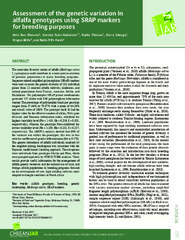Prikaz osnovnih podataka o dokumentu
Assessment of the genetic variation in alfalfa genotypes using SRAP markers for breeding purposes
| dc.creator | Ben Rhouma, Hela | |
| dc.creator | Taški-Ajduković, Ksenija | |
| dc.creator | Zitouna, Nadia | |
| dc.creator | Sdouga, Dorra | |
| dc.creator | Milić, Dragan | |
| dc.creator | Trifi-Farah, Neila | |
| dc.date.accessioned | 2021-04-26T19:34:48Z | |
| dc.date.available | 2021-04-26T19:34:48Z | |
| dc.date.issued | 2017 | |
| dc.identifier.issn | 0718-5839 | |
| dc.identifier.uri | http://fiver.ifvcns.rs/handle/123456789/1704 | |
| dc.description.abstract | The molecular diversity studies of alfalfa (Medicago sativa L.) germplasm could contribute to a more precise selection of parental populations in many breeding programs. Sequence-related amplified polymorphism (SRAP) markers were used to assess the genetic diversity of 110 individual plants from 13 selected alfalfa cultivars, landraces, and natural populations from Tunisia, Australia, Serbia, and Kazakhstan. Ten polymorphic SRAP primer combinations generated 137 alleles with 0.90 polymorphism information content. The percentage of polymorphic bands per genotype ranged from 57.66% to 70.07% with a mean of 64.29% and overall value of 100%. The genotype Sardi 10 had the highest value for the effective number of alleles; Nei's gene diversity and Shannon information index, exhibited the highest variability level (Ne = 1.453, He = 0.259, I = 0.381, respectively), whereas the genotype Nera exhibited the lowest variability level (Ne = 1.359, He = 0.211, I = 0.317, respectively). The AMOVA analysis showed that 68% of the variance was within the genotypes; this was in line with the coefficient of genetic differentiation (Gst = 0.370). The genetic relatedness of alfalfa individuals analyzed by the neighbor-joining dendrogram was consistent with the Bayesian model-based clustering approach. The exceptions were individuals from genotypes Slavija and Nera, which were grouped separately by STRUCTURE analyses. These results provide useful information for the management of alfalfa genetic resources and the rational use of local and foreign alfalfa populations in breeding programs focused on the development of new, high-yielding cultivars more adapted to drought conditions in North Africa. | en |
| dc.publisher | Inst Investigaciones Agropecuarias, Chillan | |
| dc.relation | Tunisian Ministry of Higher Education and Scientific Research [LabB02] | |
| dc.relation | info:eu-repo/grantAgreement/MESTD/Technological Development (TD or TR)/31024/RS// | |
| dc.rights | openAccess | |
| dc.source | Chilean Journal of Agricultural Research | |
| dc.subject | Alfalfa genotypes | en |
| dc.subject | breeding | en |
| dc.subject | genetic relationship | en |
| dc.subject | Medicago sativa | en |
| dc.subject | SRAP markers | en |
| dc.title | Assessment of the genetic variation in alfalfa genotypes using SRAP markers for breeding purposes | en |
| dc.type | article | |
| dc.rights.license | Publisher's own license | |
| dc.citation.epage | 339 | |
| dc.citation.issue | 4 | |
| dc.citation.other | 77(4): 332-339 | |
| dc.citation.rank | M22 | |
| dc.citation.spage | 332 | |
| dc.citation.volume | 77 | |
| dc.identifier.doi | 10.4067/S0718-58392017000400332 | |
| dc.identifier.fulltext | http://fiver.ifvcns.rs/bitstream/id/631/1701.pdf | |
| dc.identifier.scopus | 2-s2.0-85039903531 | |
| dc.identifier.wos | 000416141300006 | |
| dc.type.version | publishedVersion |


